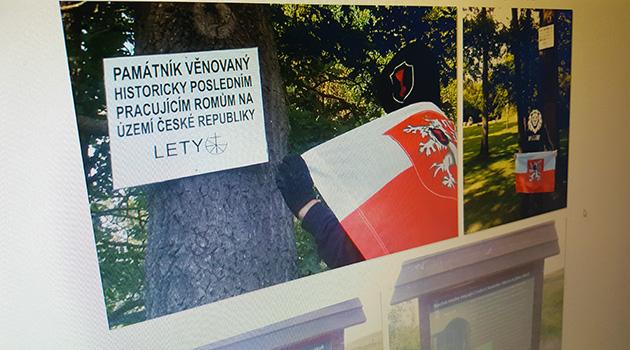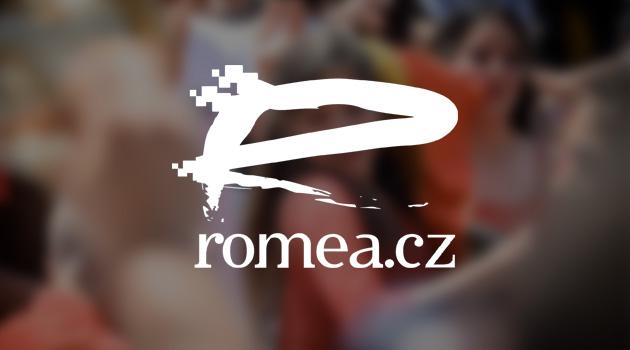Nationalists desecrate Czech memorial to genocide of the Roma

The memorial to the genocide of the Roma at Lety u Písku has been desecrated with insulting anti-Roma messages on several signs posted there by the nationalist group “Us Against All” (My proti všem). According to the police who have begun to investigate the incident it could be one of felony disorderly conduct.
“This memorial is dedicated to the historically last Romani people to ever work on the territory of the Czech Republic,” declares the insulting sign placed by the group on one of the trees near the memorial. Similar signs were placed along the hiking path that features information signage about the history.
The group has admitted desecrating the memorial on their website, which belittles the suffering of the Romani people who were imprisoned at the concentration camp. “Through this project we want to point out the absurdity of investing half a billion crowns into a non-Czech ethnic group who most probably during the entire time of their existence in our country (1918-2018) have never contributed that much money to the state budget!” the website of the group, founded by Matouš Bulíř, announced, referencing the amount of money spent by the Government to buy out the pig farm that has partially covered the site of the former concentration camp since the 1970s.
The signs are allegedly meant to draw attention to the group’s purported belief that “this was not a concentration camp as some media and politicians are saying, but a labor camp.” According to the ongoing investigation, police discovered the crime around 20 May.
“We received a report from the staffer who takes care of the grounds,” police spokesperson Kamila Čuřínová Ingrišová told news server Romea.cz. “The officers are actively investigating all the circumstances, but the qualification of the crime is not yet listed, it could be felony disorderly conduct.”
This is the second such desecration of the memorial to the suffering of Romani people during the Second World War to be perpetrated this year. In March a young man placed a pig’s head at the memorial to the Romani Holocaust located near the site of the former concentration camp at Lety.
Police have begun the prosecution of the youth (born 1991) for felony disorderly conduct. He alleges that what he did was a prank without any racist subtext.
From the history of the concentration camp at Lety u Písku
Originally the location served in the year 1940 as an accommodation facility for construction workers and was then turned into a disciplinary labor camp on the order of the Interior Minister of the Protectorate Government, Josef Ježek, given on 15 July 1940 on the basis of Government edict no. 72 about disciplinary labor camps (of 2 March 1939). That edict had been promulgated prior to the Nazi occupation.
According to the edict, “wandering gypsies capable of work and other vagabonds living that same way, professional beggars, persons living from begging done by others (children, etc.), professional gamblers, notorious bums and loiterers, and persons living from dishonorable profits (prostitution, etc.), whether their own or those of others” were to be forcibly interned in the disciplinary labor camps. The first 12 prisoners were sent to the one at Lety on 17 July 1940.
On 1 August 1942 the camp was turned into a “Gypsy Camp” and entire Romani families were then forcibly transported there. Lety began to function as a concentration camp on 1 August 1942 and was closed on 4 May 1943.
The camps’s capacity had been increased to make it able to house as many as 600 prisoners, but that number was soon exceeded, as during August 1942 more than 1 100 children, men and women were interned there. The camp was not equipped with the necessary hygienic or other kinds of facilities for such a great number of people.
The prisoners frequently had to bathe in the nearby fish pond. Prior to August 1942, only men had been imprisoned at the facility.
Beginning in August 1942, under absolutely unsatisfactory conditions, children and women were left there to rot as well. After the big intake in August 1942, those subsequently forced into the camp arrived there just a family or an individual at a time.
At least 326 people died directly in the camp at Lety, 241 of them children. There were 120 victims of the camp buried in mass grave near it.
Another 540 Lety prisoners perished after being forcibly transported to Auschwitz. A total of two mass transports to Auschwitz happened from Lety.
The first one departed on 3 December 1942, a transport of so-called “asocials” numbering 16 men and 78 women, for the Auschwitz I concentration camp. The second transport resulted in practically emptying the camp at Lety, because it involved 417 prisoners being sent to the Auschwitz II – Birkenau concentration camp.
While the first transport was implemented on the basis of a decree about crime prevention, the second was realized on the basis of Himmler’s decree from 16 December 1942 directing the transport of all Romani people to the Auschwitz concentration camp. The remaining 198 Lety prisoners were relocated to the “Gypsy Camp” at Hodonín u Kunštátu (the so-called “Žalov” site) or to internment camps in Pardubice and in Prague.
